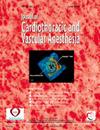高灵敏度心肌肌钙蛋白监测在胸外科手术中预测严重术后并发症的应用。
IF 2.3
4区 医学
Q2 ANESTHESIOLOGY
Journal of cardiothoracic and vascular anesthesia
Pub Date : 2025-03-15
DOI:10.1053/j.jvca.2025.03.023
引用次数: 0
摘要
目的:评价高灵敏度心肌肌钙蛋白(hs-cTn)监测在胸外科手术中根据Clavien-Dindo分级预测严重术后并发症(spoc)的应用价值。设计:回顾性、观察性队列研究。环境:三级多科医院。参与者:共有220名患者在2018年11月至2021年10月期间接受了肺切除手术,并进行了术前和术后肌钙蛋白测量。干预措施:术前和术后24小时内测量hs-cTnI水平(Abbott Alinity)。心肌损伤(MI)定义为术后hs-cTnI大于26.2 ng/L。此外,还分析了术后cTnI升高大于20%或术前低于1.6 ng/L对spoc发生的影响。记录术后前30天的并发症,并采用Clavien-Dindo分类。主要测量和结果:与无并发症的患者相比,spoc患者术前和术后hs-cTnI水平较高。心肌梗死患者的POCs发生率高于非心肌梗死患者。此外,术前检测不到的hs-cTnI水平与更好的生存率相关。结论:围手术期肌钙蛋白升高与较差的术后短期预后相关,包括较高的spoc发生率和较长的住院时间。术前hs-cTnI水平与患者术前发病率(虚弱)相关。本文章由计算机程序翻译,如有差异,请以英文原文为准。
Utility of High-Sensitivity Cardiac Troponin Monitoring in Thoracic Surgery for Predicting Severe Postoperative Complications
Objectives
To evaluate the utility of high-sensitivity cardiac troponin (hs-cTn) monitoring in thoracic surgery to predict severe postoperative complications (sPOCs) according to the Clavien-Dindo classification.
Design
Retrospective, observational cohort study.
Setting
Tertiary-level hospital involving multiple departments.
Participants
A total of 220 patients who underwent lung resection surgery between November 2018 and October 2021, with preoperative and postoperative troponin measurements.
Interventions
hs-cTnI levels (Abbott Alinity) were measured before surgery and within the first 24 hours postoperatively. Myocardial injury (MI) was defined as hs-cTnI greater than 26.2 ng/L postoperatively. In addition, the impact of a postoperative cTnI elevation greater than 20% or a preoperative value below 1.6 ng/L on the occurrence of sPOCs is analyzed. Postoperative complications were recorded for the first 30 days and classified using the Clavien-Dindo classification.
Main Measurements and Results
Patients with sPOCs had higher pre- and postoperative hs-cTnI levels compared to those without complications. Patients with MI had a higher incidence of POCs than those without MI. Additionally, undetectable preoperative hs-cTnI levels were associated with better survival.
Conclusions
Perioperative troponin elevation is associated with worse short-term postoperative outcomes, including a higher incidence of sPOCs and prolonged hospital stays. Preoperative hs-cTnI levels correlate with preoperative morbidity (frailty) in patients.
求助全文
通过发布文献求助,成功后即可免费获取论文全文。
去求助
来源期刊
CiteScore
4.80
自引率
17.90%
发文量
606
审稿时长
37 days
期刊介绍:
The Journal of Cardiothoracic and Vascular Anesthesia is primarily aimed at anesthesiologists who deal with patients undergoing cardiac, thoracic or vascular surgical procedures. JCVA features a multidisciplinary approach, with contributions from cardiac, vascular and thoracic surgeons, cardiologists, and other related specialists. Emphasis is placed on rapid publication of clinically relevant material.

 求助内容:
求助内容: 应助结果提醒方式:
应助结果提醒方式:


